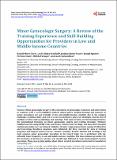| dc.contributor.author | Clark, Rachel Marie | |
| dc.contributor.author | Bradford, Leslie Siriya | |
| dc.contributor.author | Islam, Ferdous | |
| dc.contributor.author | Opoku-Anane, Jessica | |
| dc.contributor.author | Ngonzi, Joseph | |
| dc.contributor.author | Faruque, Mithila | |
| dc.contributor.author | Goodman, Annekathryn | |
| dc.date.accessioned | 2019-07-08T16:23:09Z | |
| dc.date.issued | 2014-05 | |
| dc.identifier.citation | Clark, Rachel Marie. Leslie Siriya Bradford, Jessica Opoku-Anane, Joseph Ngonzi, Ferdous Islam, Mithila Faruque, and Annekathryn Goodman. 2014. "Minor Gynecologic Surgery: A Review of the Training Experience and Skill Building Opportunities for Providers in Low and Middle Income Countries." Open Journal of Obstetrics and Gynecology 4, no. 7 (May): 432-444. | en_US |
| dc.identifier.issn | 2160-8792 | en_US |
| dc.identifier.issn | 2160-8806 | en_US |
| dc.identifier.uri | http://nrs.harvard.edu/urn-3:HUL.InstRepos:40839006 | * |
| dc.description.abstract | Purpose: Minor gynecologic surgery is the cornerstone of gynecologic evaluation and intervention in countries with a well-established medical infrastructure. Surgical training and exposure to minor procedures are not available in low and middle-income countries due to the complex challenges of patient delay and lack of access to healthcare, physician shortages, and the lack of ancillary services such as pathology and radiology. This paper reviews current training statistics, the international literature on minor gynecologic surgery and training strategies. Methods: PubMed searches using MESH terms cone biopsy, dilation and curettage, and loop electrosurgical excision procedure were performed. Statistics of minor surgical procedures among US Obstetrics and Gynecology Residency programs were tabulated. We then searched for data of training programs and surgical statistics in low resource countries. Results:Dilation and curettage is the most common minor gynecologic procedure in the United States but is performed with significantly lower frequency in low and middle-income countries. The most common procedure for the treatment of preinvasive disease was cryotherapy followed by loop electrosurgical excision procedure. There was no information about minor surgical procedures performed in hospitals in low and middle-income countries. Statistics from four-year American training programs showed an average of 209 minor cervical procedures performed annually. Conclusion: Expertise in minor gynecologic procedures is vital and requires the development of both adequate training programs and local medical infrastructure. Strategies for training in minor surgery for providers in low and middle-income countries include online curriculums, mentored relationships with senior physicians, and simulation models. | en_US |
| dc.language.iso | en_US | en_US |
| dc.publisher | Scientific Research Publishing, Inc, | en_US |
| dc.relation.isversionof | doi: 10.4236/ojog.2014.47064 | en_US |
| dash.license | LAA | |
| dc.subject | Minor Surgery | en_US |
| dc.subject | Gynecology | en_US |
| dc.subject | Dilation and Curettage | en_US |
| dc.subject | Hysteroscopy | en_US |
| dc.subject | Cone Biopsy | en_US |
| dc.subject | Residency Training | en_US |
| dc.subject | LMICs | en_US |
| dc.title | Minor Gynecologic Surgery: A Review of the Training Experience and Skill Building Opportunities for Providers in Low and Middle Income Countries | en_US |
| dc.type | Journal Article | en_US |
| dc.description.version | Version of Record | en_US |
| dc.relation.journal | Open Journal of Obstetrics and Gynecology | en_US |
| dash.depositing.author | Goodman, Annekathryn | |
| dc.date.available | 2019-07-08T16:23:09Z | |
| dash.affiliation.other | Harvard Medical School | en_US |
| dc.identifier.doi | 10.4236/ojog.2014.47064 | |
| dc.source.journal | OJOG | |
| dash.source.volume | 04;07 | |
| dash.source.page | 432-444 | |
| dash.contributor.affiliated | Goodman, Annekathryn | |


